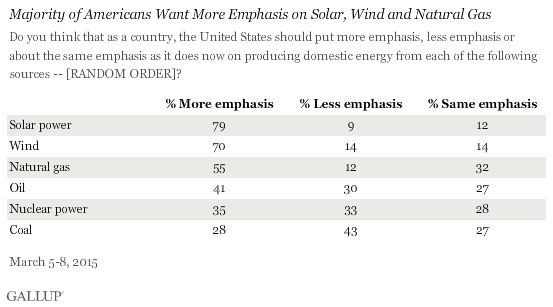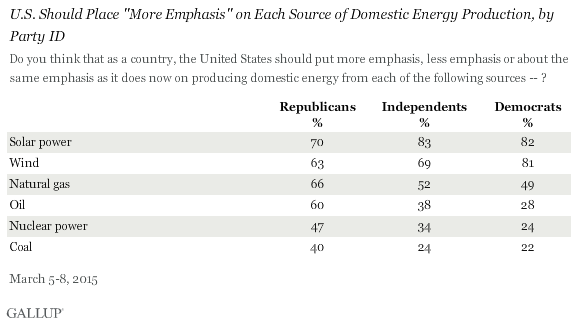
Every Spring, Gallup conducts a poll on energy issues and the Nuclear Energy Institute (NEI) usually does so too–and usually tries to beat Gallup to the punch so that it can tout its numbers first.
Not surprisingly, the NEI numbers somehow always show large public support for nuclear power.
Perhaps surprisingly, Gallup and NEI use the same basic polling question on nuclear power. But they tend to come up with very different numbers. And never have the numbers been more divergent than this year.
Gallup’s poll was released today, and showed support for nuclear power at its lowest level since 2001–the overall low point for nuclear since Gallup began regularly asking the question. According to Gallup, 51% of the American people “strongly favor or somewhat favor the use of nuclear energy as one of the ways to provide electricity in the United States.” 43% strongly or somewhat oppose nuclear when asked that question. This was an 11 point drop since nuclear’s high point just five years ago.
But in NEI’s nuclear fantasy world, support for nuclear–even when asked the exact same question–just keeps growing. NEI’s poll, conducted by Bisconti Research (principal Ann Bisconti is a former NEI employee) and released last week, found that 68% support nuclear power and only 30% oppose.
Perhaps believing its own poll numbers–so easily rebutted by Gallup–NEI seems to have joined the nuclear fantasyland populated most prominently by Sen. Lamar Alexander.
So why is there such a discrepancy? It’s pretty easy to figure out, especially since Gallup provides more detail about who supports and opposes nuclear power.

Gallup’s poll shows a marked difference in support for nuclear power from Republicans, Democrats and Independents. When asked which energy sources the country should place “more emphasis, less emphasis or about the same emphasis” on as we are placing now, 47% of Republicans said nuclear power should receive more emphasis, compared to 34% for Independents and 24% of Democrats.
If one’s poll sample is structured to count more Republicans than Gallup counts, then a poll will get a higher percentage of people favoring nuclear.
It’s the same reason Mitt Romney and his advisers thought, on the morning of election day 2012, that Romney was going to win the election. They were relying on polls that oversampled Republican voters, and chose not to believe the majority of polls that more correctly represented the population of actual voters.
What a pollster asks is one determining factor in obtaining poll results; who a pollster asks is the other main factor. And NEI’s polls, without exception, oversample those who are most likely to have a pro-nuclear bent. Of course, that’s the message NEI wants to air, and since they’re paying for the polls they make sure they get the message they want.
The rest of NEI’s poll questions do provide some interesting perspective on nuclear power issues–if one keeps in mind that the actual results are skewed. But they ask questions other pollsters don’t and the relative numbers may be of interest to people working on nuclear safety and related issues. Certainly NEI uses this kind of data to help frame its messaging.
Digging deeper into the Gallup poll, however, finds more bad news for nuclear power. First, note that in the question about emphasis on energy sources cited above, not even a majority of Republicans–nuclear’s strongest supporters–want to put more emphasis on nuclear.
Nope, what Republicans, and the public generally, want is the same in every poll conducted over the past many years: more solar and wind. Overall, as the graph at the top of this page indicates, 79% of Americans want a greater emphasis on solar; 70% want it on wind. That includes 70% of Republicans for solar and 63% for wind. Independents and Democrats come in at even higher numbers. Consistently, nuclear and coal are at the bottom of every poll no matter who is being asked.
And that’s a much more relevant question in terms of understanding the kind of energy policy Americans want to see. Sure, there are some people who buy into the “all of the above” strategy promoted both by the Obama Administration and the nuclear industry, but they’re a minority. Really, what Americans want most are renewables.
Nearly three years ago, I wrote a piece for DailyKos that attempted to make sense out of the often contradictory public opinion polls on nuclear power and energy issues generally. That piece also looked at a number of polls besides Gallup and NEI’s. Then, as now, Americans showed they are not easily fooled. They don’t buy the notion that nuclear power is “clean” energy, and genuinely clean energy is what they want, by massive margins.
Polls like NEI’s, which deliberately seek to skew the debate, are simply dishonest. You’d think politicians, who rely upon and presumably understand the inner workings of public opinion polling better than most people, would know how to read the polls on the kind of energy policy people want.
That the politicians generally don’t act to give us that kind of energy policy boils down to two factors: number one is, of course, their campaign contributions from the nuclear and fossil fuel industries which seek the exact opposite energy policy; and number two, they don’t believe–probably correctly–that energy issues are at the top of most peoples’ agendas. In other words, they don’t believe that people will determine who they vote for because of a politician’s actions on energy issues (if indeed, the average voter can even figure out what any given politician’s actions are).
We will never be able to match the first factor. But the second factor: pushing a clean energy agenda into greater national prominence, is perhaps within our reach. It’s already happening to a significant degree in many states–this year especially in Illinois (and if you live in Illinois, please take action to support clean energy and stop Exelon’s nuclear bailout, and if you know anyone who lives in Illinois, please send them to this action page).
As the EPA’s Clean Power Plan begins to come into effect over the next year, bringing with it inevitable new public debates over clean energy (the kind of debate already underway in Illinois), and with enough effort, with enough growth in our movement–and again, this is where you come in–your help in encouraging people to join NIRS’ free e-mail alert list is critical–we can make clean energy a national issue. It’s already popular–and apparently so even to climate deniers–it’s merely a matter of elevating its profile.
The tea party people embracing solar power aren’t doing so because they’re concerned about the climate crisis. That’s fine; we are, but we don’t have to convince them if they’re already with us on the solutions. The American people are with us on the solutions. Even those who support nuclear power prefer solar and wind. And enough solar and wind makes nuclear power obsolete and unnecessary. Every action we take to bring the issue to politicians at every level–whether they’re with us or against us–is another step at elevating that profile. Our ongoing action page is here. Every Alert we’ve sent out since October 2008 is here. Bookmark them. Use them. Share them.
Act, reach out, organize, mobilize. Repeat. That is our mantra; we hope you’ll make it yours too.
Michael Mariotte
March 30, 2015
Permalink: https://www.nirs.org/2015/03/30/comparing-the-opinion-polls/
Your contributions make publication of GreenWorld possible. If you value GreenWorld, please make a tax-deductible donation here and ensure our continued publication. We gratefully appreciate every donation of any size.
Comments are welcome on all GreenWorld posts! Say your piece. Start a discussion. Don’t be shy; this blog is for you.
If you’d like to receive GreenWorld via e-mail, send your name and e-mail address to nirs@nirs.org and we’ll send you an invitation. Note that the invitation will come from a GreenWorld@wordpress.com address and not a nirs.org address, so watch for it. Or just put your e-mail address into the box in the right-hand column.
If you like GreenWorld, help us reach more people. Just use the icons below to “like” our posts and to share them on the various social networking sites you use. And if you don’t like GreenWorld, please let us know that too. Send an e-mail with your comments/complaints/compliments to nirs@nirs.org. Thank you!
GreenWorld is crossposted on tumblr at https://www.tumblr.com/blog/nirsnet




Reblogged this on your passport to complaining and commented:
Sometimes having a lot of money and an incredible PR machine is not enough to keep people fooled. This won’t stop the nuclear industry from trying however.
You never heard of Truman and Dewey. TAlks about calling it wrong. Truman went to sleep thinking that he lost.
marvlewis@juno.com
Of course; with the famous photo of Truman holding up a newspaper with the headline: Dewey defeats Truman. But public opinion polling was not nearly as sophisticated in 1948 as it is today. And because of that, perhaps not as susceptible to manipulation as it is today. While most pollsters do try to get an honest outcome; some pollsters-for-hire are simply trying to create the illusion of backing for a pre-determined position.
I live in Illinois and just sent emails to my state senator and state representative. I wrote my own first paragraph and modified the first paragraph at http://org2.salsalabs.com/o/5502/p/dia/action3/common/public/?action_KEY=19803 to use as my second. Everyone in Illinois should contact their legislators to oppose Exelon and promote solar and wind power.
Hi Calamity Jean, Sounds like some letters to the editor are needed in your town. I lived in Ill. for 10 years. Suburbs of Chicago. I can remember the printed media going on about how wonderful atomic energy would be. I lived there ’65 to ’75. Now the rocking and puffing reactors will soon be colossal LIABILITIES !!! What with all the tons and tons of irradiated metals/nuclear wastes on their property.
Not only are LTE’s needed in the town, but across all of Illinois! It would be great to have them in every paper in the state….